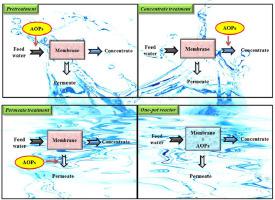Chemical Engineering and Processing: Process Intensification ( IF 4.3 ) Pub Date : 2021-09-11 , DOI: 10.1016/j.cep.2021.108631 Fatima Ezzahra Titchou 1 , Hicham Zazou 1 , Hanane Afanga 1 , Jamila El Gaayda 1 , Rachid Ait Akbour 1 , Puthiya Veetil Nidheesh 2 , Mohamed Hamdani 1

|
Wastewater treatment is becoming one of the most important issues facing the world. A large amount of effluents of different sources releases various contaminants in water bodies. Among these pollutants, organic pollutants are gaining great attention because of the related risk to their discharge into the environment. Membrane filtration, advanced oxidation processes (AOPs), and their combination have been widely applied for treating these contaminants. Ozonation, Fenton, sulfate based processes, photocatalysis and sonolysis are the main AOPs investigated in the present work. Photocatalytic ozonation, photoperoxonation and ultrasound associated to peroxonation can present higher efficiencies (> 90%) compared to conventional ozonation, being cost efficient and sustainable techniques. The association of UV and/or ultrasound irradiation to Fenton, sulfate based oxidation and photocatalysis leads to synergic effects on organic pollutants removal efficiency up to their total removal. AOPs/membranes coupled processes, i.e., AOPs as pre or post treatment for membrane systems and the one-pot configuration of AOPs/membranes were considered to showcase their potential for organic pollutant removal from wastewater based on the recent endeavors and recent publications. The enhancement of produced water quality, energy saving, environmental friendliness, and the reduction of plant capital and operating costs are the main advantages of AOPs/membranes hybrid processes.
中文翻译:

高级氧化工艺及其结合膜工艺去除废水中的有机污染物
废水处理正成为世界面临的最重要问题之一。大量不同来源的污水在水体中释放出各种污染物。在这些污染物中,有机污染物因其排放到环境中的相关风险而备受关注。膜过滤、高级氧化工艺 (AOP) 及其组合已广泛应用于处理这些污染物。臭氧化、芬顿、基于硫酸盐的工艺、光催化和声解是目前工作中研究的主要 AOP。与传统臭氧化相比,光催化臭氧化、光过氧化氢和与过氧化相关的超声波可以呈现更高的效率(> 90%),是一种成本效益高且可持续的技术。紫外线和/或超声波辐射与芬顿的关联,基于硫酸盐的氧化和光催化对有机污染物的去除效率产生协同效应,直至其全部去除。AOP/膜耦合过程,即 AOP 作为膜系统的预处理或后处理,以及 AOP/膜的一锅配置被认为展示了基于最近的努力和近期出版物从废水中去除有机污染物的潜力。AOP/膜混合工艺的主要优点是提高产出水质量、节能、环保以及降低工厂资本和运营成本。基于最近的努力和最近的出版物,AOPs 作为膜系统的预处理或后处理以及 AOPs/膜的一锅配置被认为展示了它们从废水中去除有机污染物的潜力。AOP/膜混合工艺的主要优点是提高产出水质量、节能、环保以及降低工厂资本和运营成本。基于最近的努力和最近的出版物,AOPs 作为膜系统的预处理或后处理以及 AOPs/膜的一锅配置被认为展示了它们从废水中去除有机污染物的潜力。AOP/膜混合工艺的主要优点是提高产出水质量、节能、环保以及降低工厂资本和运营成本。


























 京公网安备 11010802027423号
京公网安备 11010802027423号